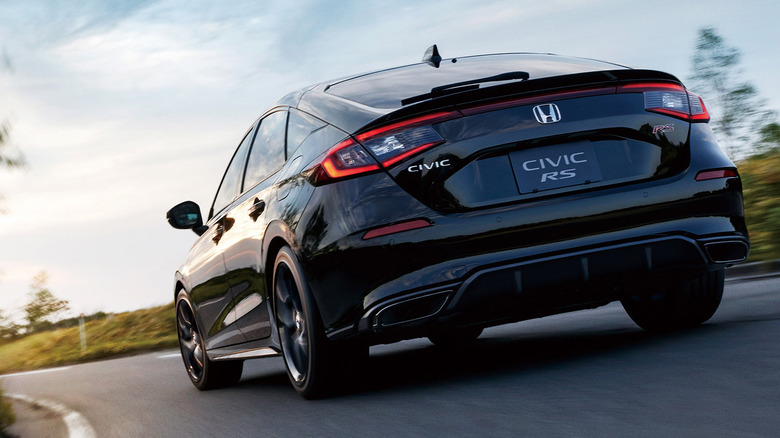What Does RS Mean On The Honda Civic & How Does It Differ From The Si?
Beyond its famous H logo, Honda is one of those brands full of badges, trims, and even technical terms that hold great value to car enthusiasts. Type R, VTEC, and Si are a few that come to mind. RS is another one that can be added to the list of famous Honda names, but it's one that probably won't be as familiar to car enthusiasts in North America.
Though RS-badged Hondas aren't found in America, the RS name has been part of Honda's sporting history for over 50 years. Originally standing for Road Sailing, the RS designation first appeared on the Civic in the early 1970s and then returned in the modern era, first on the Honda Fit and now on the current Civic, as an enthusiast-oriented model that slots below the Civic Type R.
If that last part sounds a lot like the North American Civic Si, that's because the RS does indeed have the same general mission as the sport-injected Civic Si, but there are some key differences between the two. Let's break down the evolution of the Civic RS and see exactly how it differs from the American market Civic Si.
Before there was Type R, there was RS
The Honda Civic first debuted in Japan in 1972, and it wasn't long until Honda began leaning on its high-performance, motorcycle-building expertise to create a more powerful, more sporting version of its new compact car. The result was the 1974 Civic RS, a car that would kick off a tradition of high-performance Civics that's continued for over 50 years — right up to the flagship Civic Type R of today.
Though not as track-focused as the Type Rs that would come later, the Civic RS was a hot hatchback for its time. It made 75 horsepower from its 1,200 cc, dual-carbureted engine, which was a substantial jump over the normal Civic, which made a little over 50 horsepower. It also got a five-speed transmission compared to the regular Civic's four-speed gearbox.
As for the name, the words "Road Sailing" are from the typical way that Japanese brands have used English phrases to create stylish and satisfying, if slightly strange, brand names for their vehicles. It's also been suggested that, because of the environmental movement and gas crunch of the 1970s, Honda wanted to go with a softer branding for their sporty Civic, rather than "Road Sports," which brought to mind race tracks and redline shifts.
RS Reborn
Whatever the reasoning behind the name, the RS badge was remembered fondly by Honda enthusiasts in Japan. So much so that in 2007, the name returned, not on the Civic, but on the sporting version of the second-generation Honda Fit, with lots of the same performance tweaks the Civic RS had back in the 70s. The Fit RS is still on sale today in Japan.
As for the Civic, Honda brought back the RS trim for the Japanese market Civic Hatchback in 2024 to coincide with the 50th anniversary of the original Civic RS. The JDM Civic RS is powered by Honda's 1.5-liter turbocharged four-cylinder engine, and one of its key selling points is the availability of a six-speed manual, which, for the Japanese market, was previously available only in the Type R. From our perspective, you could loosely call the Civic RS a hatchback version of the American market Civic Si sedan, but it's less powerful and lacks the Si's limited-slip differential.
Though some American Honda fans have been clamoring for a hatchback version of the Si, it's unlikely we'll get a Civic RS or a Si hatchback here. Yes, Civic Si remains one of the least expensive and most practical enthusiast cars you can buy, but it's an increasingly niche player, especially now that you can get a Civic hybrid (as a hatchback or sedan) that's quicker than the Si.


